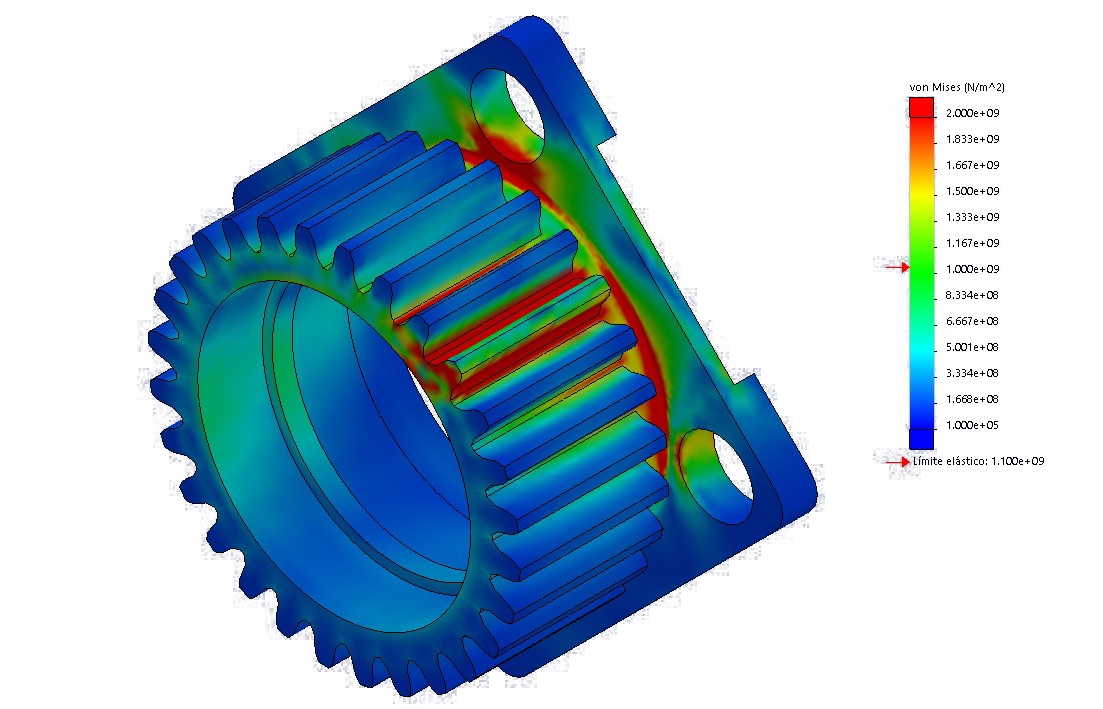Gear sizing and analysis
Timeline
2017-2023Sector
O&M, Operation and MaintenanceScope
Strength Analysis and Design of GearsBACKGROUND
Strength analysis and design of gears is essential in the development of machinery in different productive sectors. To carry this out properly we must apply a methodology that includes selecting the right type of gear for the application, define its geometric parameters, the appropriate material and the applied loads.
In the process, standard ISO 6336 is applied, which covers calculating the mechanical strength and CAD and FEM software as tools for drafting manufacture drawings and configuring design validation simulations. This involves new components as well as others that have already been manufactured.
In the wind sector, SOLUTE has specific experience in strength analysis of manufactured gears by applying reverse engineering skills. This know-how can be applied in other sectors to determine the useful service life of used gears in other machines or devices.
Gears are an essential part of the operation of machines in many industrial sectors since they are used to transmit power in a wide variety of applications without allowing any play between the coupled shafts, making them highly efficient and widely used.
By using gears we are able to set the required torque and speed of the transmission shafts (parallel or crossed) of different devices and machines in a manner that is continuous and reliable.
Through the design and strength analysis of gears, the aim is to comply with all the design requirements of the desired application, which includes the use of the proper type of gear (straight, spiral or tapered teeth), the geometric parameters (sizes, transmission ratios) as well as the optimum strength for the operating conditions (material, loads, pitch speed). We are also able to evaluate an existing design through reverse engineering to obtain its parameters and evaluate its mechanical strength.
RESULTS
The result of the analysis is provided in a calculation report with all the information about the gear or set of gears, required for the manufacture (manufacture drawings) and/or validation of its use for a specific application (calculations, simulations).
EXPERIENCE
Within the interest groups, companies in the industrial, automotive and wind sector are worth mentioning since in their productive processes, they use machinery like gearboxes (parallel shaft or planetary gear type), rack and pinion systems, slewing rings, differentials, among other applications.
SOLUTE has developed this capability especially in the wind sector, applying reverse engineering on blade bearing rings and being able to determine the strength of the gears under new operating conditions and thus predict their useful service life.
The designing of bearings is based on standard ISO 6336 and in cases that require it, on regulations from the American Gear Manufacturers Association (AGMA).
METHODOLOGY
The designing of bearings is based on standard ISO 6336 and in cases that require it, on regulations from the American Gear Manufacturers Association (AGMA). For the 3D design and kinematic analysis, SOLIDWORKS is used and to evaluate the mechanical strength, finite elements software is used such as OPISTRUCT (ALTAIR) or ANSYS.
A first step is to define the type of gear (or pair of gears) and its geometric parameters (module, number of teeth) based on the application. Also to be considered in the process, among other factors, is the type of tooth profile that is required (angle of contact), the minimum number of teeth to prevent interference, the available space and the speed of operation. This is followed by the mechanical strength analysis, where the contact forces of the gear teeth is obtained under the operating conditions (input power) and proper material is selected along with its properties. The contact stresses and the stresses on the root of the tooth are obtained by applying calculation factors from ISO 6336, which are compared with the admissible limit of the material applying a failure criteria theory (Von Mises). Finally, the result is validated through a finite elements simulation.
Technical type characteristics and requirements in the design and the validation of gears may vary depending on the application, henceforth, we adapt our know-how and capabilities to the project in order to offer the best possible assessment tailored to each need.
Automotive
Low speed impacts
Using finite element modelling (FEM), and thanks to simulation, we can obtain the most suitable part designs to reduce potential damage and save development costs.
Wind
Wind turbine tower and foundation design Peer review & RCA
Detailed data evaluations to ensure components are compliant with current regulations and the quality standards that are currently defined.
